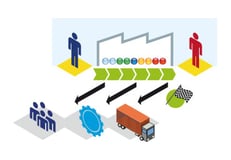5 Fascinating Facts About Advanced Analytics
Brian Hoey - May 03, 2018

 Advanced analytics continues to be one of the most talked about new advances in supply chain technology. Also known as big data analytics, this increasingly-important tool can increase the power and accuracy of a given company’s predictive forecasts and suggest prescriptive process improvements by analyzing mountains of information that would be impossible to comprehend if they had to be analyzed by hand. While integrating this new technology remains a significant pain point for many manufacturers, it also represents a unique chance (especially in the early days of its widespread adoption) for businesses to gain a competitive advantage and increase revenue. Here are some surprising facts about it:
Advanced analytics continues to be one of the most talked about new advances in supply chain technology. Also known as big data analytics, this increasingly-important tool can increase the power and accuracy of a given company’s predictive forecasts and suggest prescriptive process improvements by analyzing mountains of information that would be impossible to comprehend if they had to be analyzed by hand. While integrating this new technology remains a significant pain point for many manufacturers, it also represents a unique chance (especially in the early days of its widespread adoption) for businesses to gain a competitive advantage and increase revenue. Here are some surprising facts about it:
As of only a few years ago, most companies were analyzing a mere 12% of their data
Though that number has no doubt grown in recent years, it’s a useful indication of the untapped power of the information that most companies gather whether they intend to or not. Sure, some of this information would likely prove ancillary to meaningful business goals and workflow improvements, but much of it hasn’t been analyzed because of the presence of information silos that present operational roadblocks within their respective organizations. As Industry 4.0 continues to promote connectivity and visibility within and without manufacturers and other businesses, supply chain managers may finally begin to break down those planning silos and integrate the information hidden within them into analytics workflows.
According to Cisco, more than 50 billion smart, connected devices will be collecting data within the next 2 years
A huge component of the rise of big data analytics and machine learning has been the overall proliferation of information being collected and stored by devices around the world. Not just laptops and smart phones but Fitbits, connected smart home devices, automobiles, and other internet-of-things (IoT) devices are tracking information on a scale that would have been inconceivable even a few decades ago. This trend will have an especially meaningful impact on shipping and manufacturing spheres as the rise of the “smart factory” continues to drive an increase in internet connected devices informing and tracking production and transport processes. While it’s difficult to estimate just how many of the 50 billion new connected devices will be integrated within factories or shipping fleets, you can be sure that it will be more than enough to further the data revolution that's changing the nature of countless industries.
But most IT professionals are not prepared for the IoT explosion
Although the exponential growth in data that’s powering the rise of advanced analytics is a widely acknowledged fact, 59% of IT professionals (according to one survey) aren’t currently taking steps to prepare for it. This means that even as big data analytics become a more and more significant value-added proposition, many businesses won’t be in a position to integrate analytics into their existing workflows and, more broadly, won’t be able to leverage their data into actionable business insights. The power of analytics to drive significant process and forecast improvement will translate into meaningful competitive advantages for many businesses going forward, but only those that work to increase data visibility, connectivity, and integration intra-operationally.
Increasing data accessibility can boost revenue
By Baseline’s 2014 estimation, a 10% boost in data accessibility yielded more than $65 million in added income for the average Fortune 1000 company. As alluded to above, part of the reason that data visibility is so valuable is the important role that it plays in analytics workflows. What’s crucial about this figure, however, is that the true value of advanced analytics is no longer theoretical—it is a proven fact of the modern business world. While technology will always continue to evolve, often leaving companies scrambling to adapt to changing marketplaces, the information we have today suggests that big data analytics is a value-added proposition that belongs not to future business leaders, but to savvy decision makers willing and able to work towards outpacing their competitors
At the end of the day, advanced analytics is just a tool
Yes, data is a force to be reckoned with, and analytics tools are able to provide previously unforeseen predictive and prescriptive power, but the value of any tool is in how it’s used. As you (hopefully) consider integrating advanced analytics into your value chain, it’s important to make sure that any technology you adopt is aligned clearly with specific operational goals. For instance, if your aim is to combat short-term volatility in your supply stream, you might conscientiously adopt a predictive solution that can improve forecasts pertaining to your key areas of disruption. If, on the other hand, you know your transport planning to be a pain point, prescriptive analytics aimed at improving transportation workflows might be a worthwhile goal. In both of these instances, it’s crucial to get buy-in from key stakeholders and decision makers, including the IT professionals who can integrate any new solutions into your overall ERP structure, but the potential effects on your value chain will be impossible to ignore.
LATEST POSTS
- Understand Why Production Planning Needs Specialized Solutions
- Understand Circular Economy in The Manufacturing Industry
- How Can Industry 4.0 IT Integration Be Achieved Smoothly?
- The Significance of Order Sequencing in Discrete Manufacturing
- How to improve your Supply Chain Management: The Power of Control Towers



